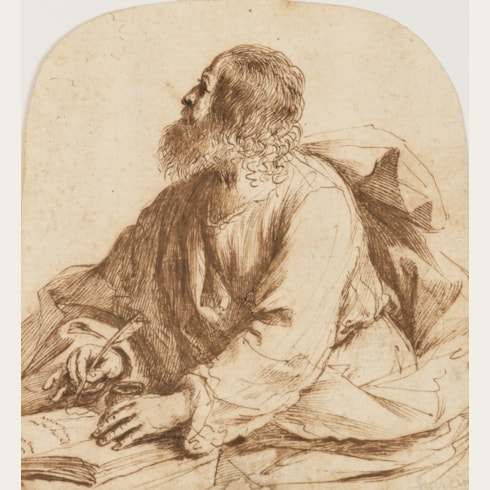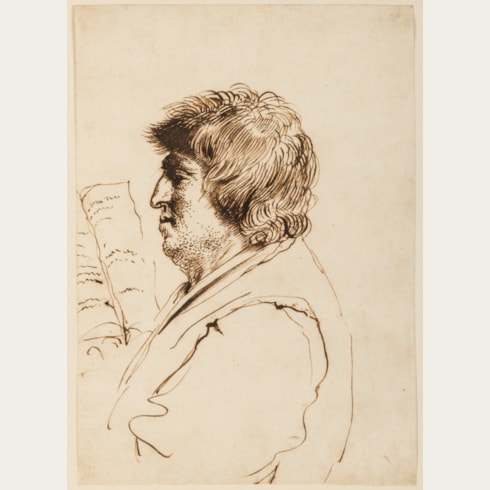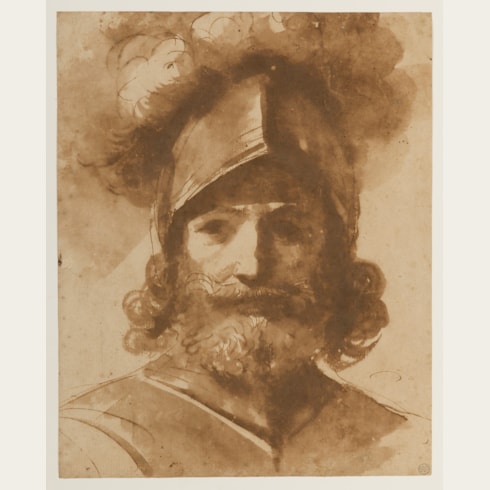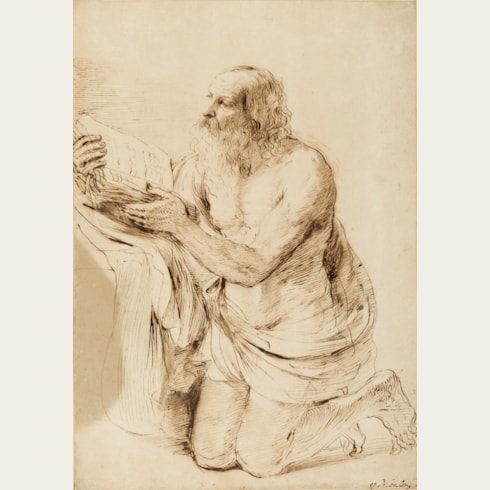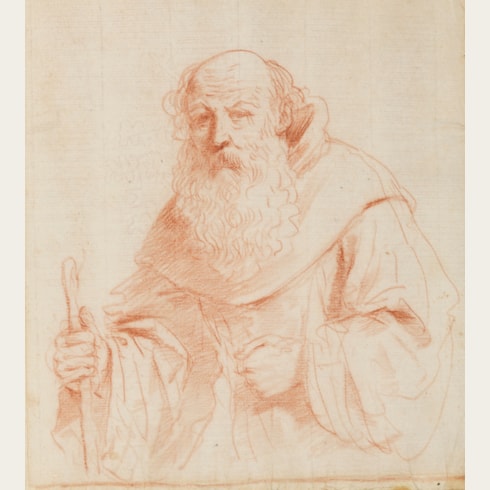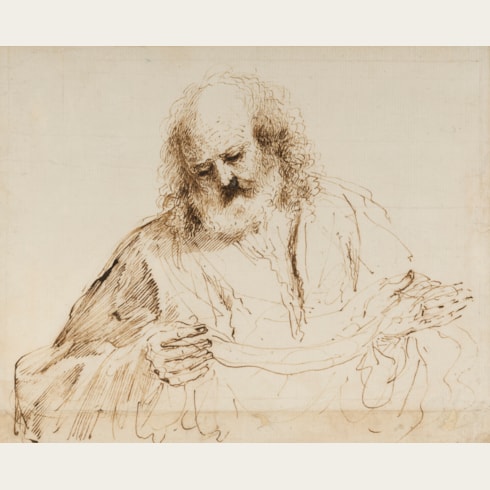Giovanni Francesco Barbieri GUERCINO
(Cento 1591 - Bologna 1666)
The Death of Saint Joseph
Squared for transfer in red chalk, and with the borders of the sheet painted in gold ink.
Inscribed Guercino on the verso.
372 x 410 mm. (14 5/8 x 16 1/8 in.)
Watermark: An anchor in a circle.
The subject of the death of Saint Joseph is relatively rare in Italian art. The episode is not found in the Bible, and indeed the life of the saint in the years after the childhood of Jesus remains something of a mystery. Saint Joseph disappears from the canonical Gospel texts when Jesus is still around twelve years old, after the episode where the young Christ is found debating with the elders in the Temple. Unlike Mary, Joseph does not appear in any New Testament accounts of Christ’s adult life, and he is assumed to have died before Christ began his ministry. Apocryphal texts claim that Joseph died peacefully, at an advanced age and with Jesus and Mary by his side, and as such he is venerated as the patron saint of a happy death.
Among stylistically comparable late drawings by Guercino is a study of Saint Luke Painting a Canvas of the Virgin and Child on an Easel, drawn in a combination of black and red chalk, in the Royal Collection at Windsor Castle. Three highly finished drawings related to an Ecce Homo painting, commissioned from Guercino in 1647 and now in the Bavarian State Painting Collection in Munich, are also comparable, in their use of red and black chalk, to the present sheet. These are a Christ Crowned with Thorns and a Mocking of Christ, both in the Pierpont Morgan Library in New York, and a third Ecce Homo drawing in the Goldman collection in Chicago.
The present sheet bears the collector’s mark of William S. Brough (d.1919), a Justice of the Peace who collected both prints and drawings, and may also have worked as a dealer in works on paper.
Giovanni Francesco Barbieri, known as Il Guercino (‘the squinter’) because he was cross-eyed, was by the second decade of the 17th century one of the leading painters in the province of Emilia. Born in Cento, a small town between Bologna and Ferrara, Guercino was largely self-taught, although his early work was strongly influenced by the paintings of Ludovico Carracci. In 1617 he was summoned to Bologna by Alessandro Ludovisi, the Cardinal Archbishop of Bologna, and there painted a number of important altarpieces, typified by the Saint William Receiving the Monastic Habit, painted in 1620 and now in the Pinacoteca Nazionale in Bologna. When Ludovisi was elected Pope Gregory XV in 1621, Guercino was summoned to Rome to work for the pontiff and his nephew, Cardinal Ludovico Ludovisi. It was in Rome that Guercino painted some of his most celebrated works, notably the ceiling fresco of Aurora in the Casino Ludovisi and the large altarpiece of The Burial and Reception into Heaven of Saint Petronilla for an altar in Saint Peter’s. The papacy of Gregory XV was short-lived, however, and on the death of the Pope in 1623 Guercino returned to his native Cento. He remained working in Cento for twenty years, though he continued to receive commissions from patrons throughout Italy and beyond, and turned down offers of employment at the royal courts in London and Paris. Following the death of Guido Reni in 1642, Guercino moved his studio to Bologna, where he received commissions for religious pictures of the sort that Reni had specialized in, and soon inherited his position as the leading painter in the city.
Guercino was among the most prolific draughtsmen of the 17th century in Italy, and his preferred medium was pen and brown ink, although he also worked in red chalk, black chalk, and charcoal. He appears to have assiduously kept his drawings throughout his long career, and to have only parted with a few of them. Indeed, more drawings by him survive today than by any other Italian artist of the period. On his death in 1666 all of the numerous surviving sheets in his studio passed to his nephews and heirs, the painters Benedetto and Cesare Gennari, known as the ‘Casa Gennari’.
The drawings of Guercino, which include figural and compositional studies, landscapes, caricatures and genre scenes, have always been coveted by later collectors and connoisseurs. Indeed, the 18th century amateur Pierre-Jean Mariette noted of the artist that ‘Ce peintre a outre cela une plume tout-à-faite séduisante’. The largest extant group of drawings by Guercino is today in the Royal Collection at Windsor Castle; these were acquired from the Gennari family by King George III’s librarian, Richard Dalton, between about 1758 and 1764.
Provenance
Purchased after Lawrence’s death, together with the rest of his collection, by Samuel Woodburn, London, in 1834
His posthumous sale (‘The Valuable and Important Collection of Drawings, By the Old Masters, Formerly in the Collection of the Late Sir Thomas Lawrence, P.R.A., And more recently the Property of that Distinguished Connoisseur, Samuel Woodburn Esq., Deceased’), London, Christie’s, 4-8 June 1860, lot 480 (‘Guercino de Cento…The death of St. Joseph – black and red chalks’)
William S. Brough JP, London and Leek, Staffordshire (Lugt 2652)
His posthumous sale, London, Sotheby Wilkinson & Hodge, 19 May 1919, part of lot 31 (twelve drawings by various artists, including a ‘Death of St. Joseph, by Guercino’)
Private collection, Switzerland
Anonymous sale, Zurich, Koller, 20 September 2008, lot 3411
Nicolas Schwed, Paris
Private collection, New York.
Exhibition






















